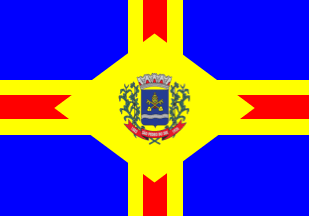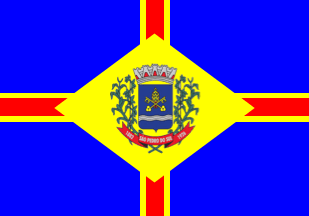 image by Ivan Sache, 5
August 2020
image by Ivan Sache, 5
August 2020
Last modified: 2020-08-08 by ian macdonald
Keywords: rio grande do sul | são pedro do sul |
Links: FOTW homepage |
search |
disclaimer and copyright |
write us |
mirrors
 image by Ivan Sache, 5
August 2020
image by Ivan Sache, 5
August 2020
he Municipality of São Pedro do Sul (16,371 inhabitants in 2010; 87,359 ha)
is located 360 km north-west of Porto Alegre.
São Pedro do Sul was
established in 1866 by Crescêncio José Pereira, who offered a 14-ha plot to
erect a chapel and free plots to colonists. The place was successively known as
São Pedro do Rincão, Rincão de São Pedro, São Pedro, and eventually, São Pedro
do Sul.
The municipality of São Pedro do Sul was established by State Decree
No. 3,624 issued on 22 March 1926, separating from Santa Maria.
https://saopedrodosul.rs.gov.br/
Municipal website
Ivan Sache, 5 August 2020
A red centred upright cross, bordered yellow, on blue with the coat of arms centred
on a yellow lozenge.
Dirk Schönberger, 1 April 2012
The flag and arms of São Pedro do Sul are prescribed by Municipal Law No. 1,236
promulgated on 8 August 1975.
Article 6.
The municipal flag of São
Pedro do Sul, designed by the heraldist Arcinoé Antonio Peixoto de Faria, shall
be quartered by a cross, with blue quarters formed by four yellow stripes of two
units in width superimposed with red stripes of one unit, starting from the
angles of a yellow lozenge of six units in width on eight units in length
charged with the municipal coat of arms.
§1. In compliance with the
Portuguese heraldry traditions, and their inherited canons and rules, municipal
flags have to be divided in eight or six horizontal stripes, quartered or
divided in three parts, featuring the same colors as the field of the coat of
arms and in the center or at hoist a geometrical figure inscribing the municipal
coat of arms.
§2. The municipal flag of São Pedro do Sul obeys this general
rule, being quartered by a cross, symbolizing the people's Christian spirit. The
coat of arms applied on the flag represents the municipal government while the
yellow lozenge represents the town as the municipal seat. Yellow is a symbol of
glory, splendor, greatness, richness and sovereignty. The yellow stripes charged
with red stripes starting from the lozenge and quartering the flag represent the
spread of municipal power all over the territory. Red is a symbol of dedication,
patriotic love, audacity, intrepidity, courage and valiance, while the blue
quarters represent the rural estates scattered over the municipal territory.
Blue symbolizes justice, nobleness, perseverance, zeal and loyalty.
Article 7.
In compliance with heraldic rules, the municipal flag shall have
the official dimensions adopted for the national flag, 14 units in width on 20
units in length.
Article 19.
The coat of arms of São Pedro do Sul,
designed by the heraldist Arcinoé Antonio Peixoto de Faria,is described as
follows:
A Samnite shield surmounted by an eight-towered mural crown argent
ports gules. On a field azure a Papal tiara superimposed with two crossed keys
all or the tiara fimbriated gules. In base a fess wavy argent. The shield
surrounded dexter and sinister by soybean and maize plants proper crossed in
base and superimposed by a scroll gules containing in letters argent the toponym
"São Pedro do Sul" surrounded by years "1892" and "1896".
The coat of
arms has the following symbolic interpretation:
a) The Samnite shield, used
to represent the arms of São Pedro do Sul, was the first style of shield
introduced to Portugal under French influence, inherited by Brazilian heraldry
to evoke the colonizing race and main builder of the nation;
b) The mural
crown surmounting the shield is the universal symbol of coat of arms of domains;
argent (silver) with eight towers, five visible in perspective, it classifies
the town as a county seat. The port gules, heraldically meaning dedication,
patriotic love, audacity, intrepidity, courage and valiance, represent the moral
skills required for county's leaders.
c) Azure (blue) symbolizes justice,
nobleness, perseverance, zeal and loyalty.
d) In the center the Papal tiara
superimposed with two crossed keys all or is the heraldic symbol of St. Peter,
the town's patron saint and namesake, making the arms canting.
e) Or (yellow)
is a symbol of glory, splendor, greatness, richness and sovereignty.
f) In
base the fess wavy argent (silver) represents river Torpoi, of great economical
significance, which is suitable for irrigation and allowed the region to be
densely cropped and increased agricultural production.
g) Argent (silver) is
a symbol of peace, friendship, work, prosperity, purity and religious feeling.
h) The outer ornaments, soybean and maize, represent the main products of the
generous and fertile soil.
i) On a scroll gules (red), in argent (silver)
letters the identifying toponym "São Pedro do Sul" surrounded by the date of
foundation, "1882", and of political emancipation, "1926".
https://leismunicipais.com.br/a/rs/s/sao-pedro-do-sul/lei-ordinaria/1975/124/1236/lei-ordinaria-n-1236-1975-dispoe-sobre-a-forma-e-a-apresentacao-dos-simbolos-municipais-do-municipio-de-sao-pedro-do-sul-e-da-outras-providencias
Leis Municipais database
Photos
https://www.facebook.com/prefeituramunicipaldesaopedrodosul/photos
https://www.facebook.com/prefeituramunicipaldesaopedrodosul/photos
https://www.facebook.com/prefeituramunicipaldesaopedrodosul/photos
https://www.facebook.com/prefeituramunicipaldesaopedrodosul/photos
The flag is also used with a thinner cross and a bigger coat of arms.
 image by Ivan Sache, 5
August 2020
image by Ivan Sache, 5
August 2020
Photos
https://www.facebook.com/prefeituramunicipaldesaopedrodosul/photos
https://www.facebook.com/prefeituramunicipaldesaopedrodosul/photos
Ivan Sache, 5 August 2020